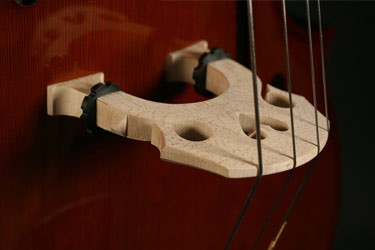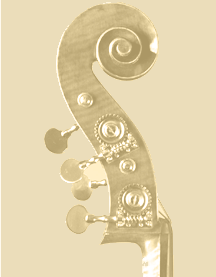What About The Bass Bridge?
 Many
upright bass players looking to buy an upright bass, an upgrade or
even their first bass, hardly ever think about the piece of maple
holding up their strings on the top. No matter how incredible or
valuable the bass may be worth, if the bass bridge is not the right
size, the right fit, or even the right type, it could seriously
alter the whole character of the instrument. While the most
important responsibility of a bridge is to safely hold the strings
at the proper height and spacing, it "bridges" the sound of that
vibrating string onto and into the body of the bass. I have
personally heard so many incredible differences in tone and
responsiveness by even the slightest changes in the bridge.
There are two major companies in the world that specialize and sell
bridges: Aubert and Despiau (both based in France.) Another
company, Teller, is based in Germany is slightly cheaper than the
French ones, but most prefer the French and will pay more for them. Many
upright bass players looking to buy an upright bass, an upgrade or
even their first bass, hardly ever think about the piece of maple
holding up their strings on the top. No matter how incredible or
valuable the bass may be worth, if the bass bridge is not the right
size, the right fit, or even the right type, it could seriously
alter the whole character of the instrument. While the most
important responsibility of a bridge is to safely hold the strings
at the proper height and spacing, it "bridges" the sound of that
vibrating string onto and into the body of the bass. I have
personally heard so many incredible differences in tone and
responsiveness by even the slightest changes in the bridge.
There are two major companies in the world that specialize and sell
bridges: Aubert and Despiau (both based in France.) Another
company, Teller, is based in Germany is slightly cheaper than the
French ones, but most prefer the French and will pay more for them.
What makes some bass bridges more expensive than others?
First, both Aubert and Despiau grade their bridges by the quality of
the grain (medullary rays) that appear on the top of the bridge
grain. While the 'grainier' wood costs more, it isn't actually
harder, so they tend to sound the same, regardless of super dense
grain or wider (less) grainy. Despiau grades their bridges by
the grain type and appoints 3 trees (stamped) on top, 2 trees, 1 or
plain, no tree (for student or cheaper instruments). Again,
the tree stamps really denote the attractiveness of the wood.
Also (as Despiau) says on their website, the older stored seasoned
wood costs a premium as well. The wood should be old enough
that it won't warp easily after being installed and will hold up for
many years. On our Thompson upright basses (both plywood and
hybrid models), we use choice wooden bridges: Very dense, solid
(treated) maple. While the wood comes from China they are
special ordered from a specialist source and are the best maple bass
bridges you can find. We use our favorite Aubert pattern for
the Thompson basses and we can hear a nice difference: They tend to
have a lower fundamental and punchy response.
Even the thickness or shape can change the sound and response of
the instrument. In most of the world, (with the exception of
USA and Canada), upright bass players tend to not use any kind of
bridge (height) adjusters. Like their smaller instrument
brethren (cellos, violas and violins) you'll hardly ever see any
kind adjusters on European players' basses. While the
percentage of seasonal changes are the same, 4% on a bass is far
more noticeable on a bass than it is on a cello!! In the
summer where it normally gets more humid, the strings almost always
go higher on the instrument. Some cellos can change so much
that some players can go between two bridges throughout the year so
that the strings won't be too hard to play on in the summer or too
low in the winter. In Europe, some bass players also
will use two bridges and here, (in the USA) many fully carved basses
do well with a winter AND a summer sound post for this very same
reason. For the ones that elect not to use adjusters and where
the climates are more seasonal, they need two bridges: A shorter one
for the summer and a higher one for winter. For people that set up basses and work on them all day long...it
still never ceases to amaze us how much character can be altered by
the shape and thickness of the bridge.
At the moment of this
writing, we received a beautiful
French
Thibouville Lamy Bass (circa 1890). It came with a pretty ugly, crude bridge
though and that was the first thing we changed on the bass.
First, when the bass arrived, it immediately sounded beautiful:
Nice tone, not bright or edgy sounding like some French basses can
be, but had crude looking old aluminum bridge adjusters and the feet
didn't even fit right! We put a nice Aubert bridge and our
special Delrin (black) adjusters.
When first selecting the bridge size, the bridge (bass bar side)
foot should be centered right over the center of the bass bar.
If you do not know what a bass bar is, it can be found inside the
bass top, right next to the f hole (E string side). The center
of the bass foot should be centered right over the middle of the
bass bar on the inside of the bass. The other foot of the
bridge is then usually placed so that it is equally distant from the
other side from the f-hole (on the G string side.) as is the E
string side. Sometimes even the best, most incredible basses
can have an off center and/or off kilter neck placement so that
fitting the bridge properly also has to wrestle with the placement
of where the neck is placed! Every bass is different.
Usually for a 3/4 size bass, the typical bridge width is 150mm,
though by careful placement and measurement, if the bass bar center
requires a slightly wider bridge, say 154mm can really add to the
lower end quality of the bass. Again it depends on where the
bass bar is inside the bass. By adding a bridge that is too
wide is just as bad as one that is too narrow.
Getting back to that Lamy bass! Changing the
thickness of a bridge in either direction can have astonishing
results (both good or bad!) When fitting a new bridge, we
first fit the bridge perfectly and also with the same exact optimal
playing height that we want on the bass. We then play the bass
(without the bridge adjusters installed yet!!!) to first get the
exact sound we want, the tone, and to see how the bass responds.
Only after we are happy with the way the bass is playing, do we then
install the Delrin bridge adjusters. On the Lamy bass, the new
bridge was thicker than the original one that came with the bass.
The bass seemed also a little fuller (bigger) sounding, but at the
same time, I noticed the G string a bit tight and not as responsive.
So, starting with a fatter bridge is preferable because we can
always go less and less, but it's very difficult to add any wood
back on! A bridge that is too thin can easily warp and loose a
little power or definition. A bridge that is left too thick
can have the opposite approach: Too bright sounding, and while there
might be some additional feeling of lower end power, might also take
off the response of the high string(s) or higher registers.
Everything is tradeoff and it is always fun so that when a player
knows his bass well, to play it with the his/her luthier to find the
'sweet' spot.
More about the black Delrin adjusters. Delrin is a self
lubricating, high density material and it will never bind inside of
a maple bass bridge. Anyone that has experienced those super
tight aluminum adjusters knows how hard it can be when trying to get
them to turn when the bridge has dried a little or shrunk in the
winter. This is why we see so many chewed up looking bass
bridges because the player has had to use plyers on the adjusters
and they always catch the wood and chip it off. Also, we find
that Delrin interferes less and matches the acoustical wood
properties better than aluminum, whereas brass tends to even mute
the bridge and vibration.
Why most players do not use bridge adjusters in Europe?
I think...mostly, it is out of tradition, but they (Europeans)
rightly ascertain that the adjusters can interfere with the sound of
bridge and the bass. I have personally kept and played on my
own bass without using bridge adjusters and the hassle with the
changes in Phoenix (winter) proved too much for me to want to keep
it that way. I like to play on low string height and so when
the bass shrunk in the winter the strings got so low that they
buzzed. Back went the bridge adjusters! To be honest,
strangely to me, I kind of liked the way my bass played with the
bridge adjusters
in
more than without! For some odd reason (my G string felt more
'stubborn') and edgy without bridge adjusters and then when I added
them in, the problem went away, but the bass still sounded pretty
much the same everywhere else. Some swear that by playing
without the bridge adjusters is the purest and only way to go.
That is maximizes the tonal and playing spectrum of the instrument,
whereby the adjusters can potentially interfere with some of that.
Maybe so, but on most basses it seems to be a negligible amount.
(My opinion....) The adjusters can really make a huge
difference and besides the obvious playing height, also change the
pressure and tension on the bass which can also 'play' a role in the
end result of the tone and response. In the end, there's no
right or wrong answer or perfect solution. Every bass is
different and each player has his own idea of what he or she likes
or needs the bass to do. |


